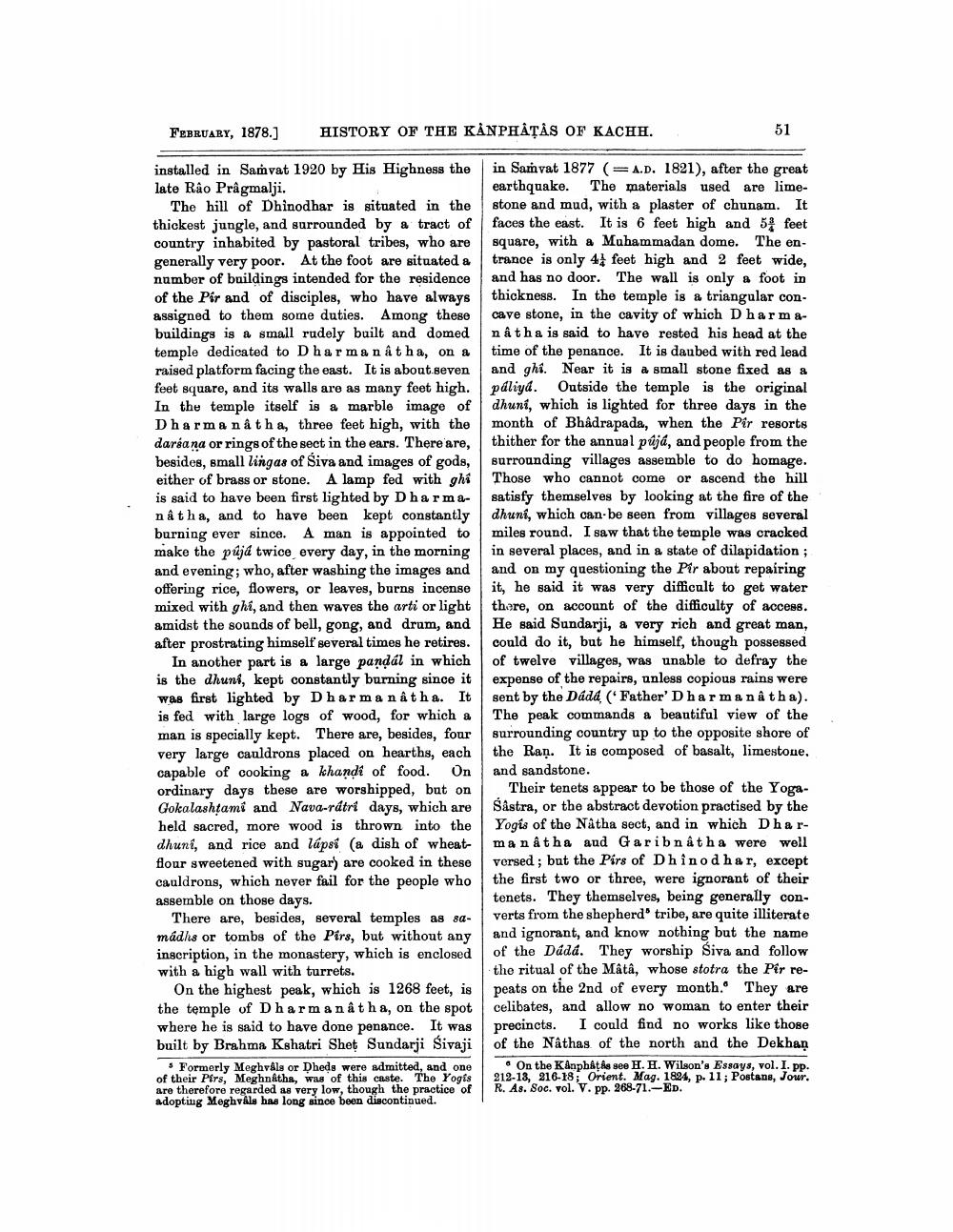________________
FEBRUARY, 1878.]
HISTORY OF THE KÅNPHÂTÅS OF KACHH.
51
installed in Samvat 1920 by His Highness the late Râo Pragmalji.
The hill of Dhinodhar is situated in the thickest jungle, and surrounded by a tract of country inhabited by pastoral tribes, who are generally very poor. At the foot are situated a number of buildings intended for the residence of the Pir and of disciples, who have always assigned to them some duties. Among these buildings is a small rudely built and domed temple dedicated to Dharma na tha, on a raised platform facing the east. It is about seven feet square, and its walls are as many feet high. In the temple itself is a marble image of Dharma na tha, three feet high, with the darsana or rings of the sect in the ears. There are, besides, small lingas of Siva and images of gods, either of brass or stone. A lamp fed with ghi is said to have been first lighted by Dharmanátha, and to have been kept constantly burning ever since. A man is appointed to make the půjd twice every day, in the morning and evening; who, after washing the images and offering rice, flowers, or leaves, burns incense mixed with ghi, and then waves the arti or light amidst the sounds of bell, gong, and drum, and after prostrating himself several times he retires.
In another part is a large pandal in which is the dhuni, kept constantly burning since it was first lighted by Dharma natha. It is fed with large logs of wood, for which a man is specially kept. There are, besides, four very large cauldrons placed on hearths, each capable of cooking a khandi of food. On ordinary days these are worshipped, but on Gokalashtami and Nava-rátri days, which are held sacred, more wood is thrown into the dhuni, and rice and lápsi (a dish of wheatflour sweetened with sugar) are cooked in these cauldrons, which never fail for the people who assemble on those days.
There are, besides, several temples as sa- mádhs or tombs of the Pirs, but without any inscription, in the monastery, which is enclosed with a high wall with turrets.
On the highest peak, which is 1268 feet, is the temple of Dharmanatha, on the spot where he is said to have done penance. It was built by Brahma Kshatri Shet Sundarji Sivaji
Formerly Meghvala or Dhede were admitted, and one of their Pirs, Meghnátha, Wie of this caste. The Yogis are therefore regarded as very low, though the practice of adopting Meghváls has long since been discontinued.
in Samvat 1877 ( A.D. 1821), after the great earthquake. The materials used are limestone and mud, with a plaster of chunam. It faces the east. It is 6 feet high and 54 feet square, with a Muhammadan dome. The entrance is only 4 feet high and 2 feet wide, and has no door. The wall is only a foot in thickness. In the temple is a triangular concave stone, in the cavity of which Dharmanatha is said to have rested his head at the time of the penance. It is daubed with red lead and ghi. Near it is a small stone fixed as a páliya. Outside the temple is the original dhuni, which is lighted for three days in the month of Bhadrapada, when the Pir resorts thither for the annual pújá, and people from the surrounding villages assemble to do homage. Those who cannot come or ascend the hill satisfy themselves by looking at the fire of the dhuni, which can be seen from villages several miles round. I saw that the temple was cracked in several places, and in a state of dilapidation ; and on my questioning the Pir about repairing it, he said it was very difficult to get water thore, on account of the difficulty of access. He said Sundarji, a very rich and great man, could do it, but he himself, though possessed of twelve villages, was unable to defray the expense of the repairs, unless copious rains were sent by the Dádd ( Father' Dharmanatha). The peak commands a beautiful view of the surrounding country up to the opposite shore of the Ran. It is composed of basalt, limestone, and sandstone.
their tenets appear to be those of the YogaSastra, or the abstract devotion practised by the Yogis of the Natha sect, and in which Dharmanatha aud Garibnatha were well versed; but the Pirs of Dhinodhar, except the first two or three, were ignorant of their tenets. They themselves, being generally converts from the shepherd' tribe, are quite illiterate and ignorant, and know nothing but the name of the Dáda. They worship Siva and follow the ritual of the Mâtâ, whose stotra the Pir repeats on the 2nd of every month. They are celibates, and allow no woman to enter their precincts. I could find no works like those of the Nathas of the north and the Dekhan
On the KinphâţAs see H. H. Wilson's Essays, vol. I. pp. 212-13, 216-18; Orient. Mag. 1824. D. 11: Postans. Jour. R. As. Soc. vol. V. pp. 268-71.-ED.




